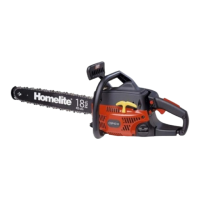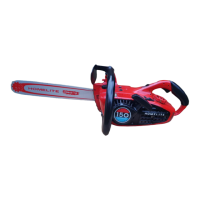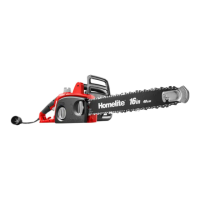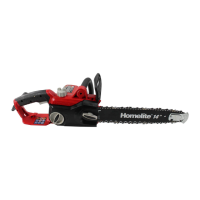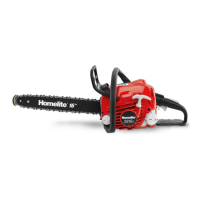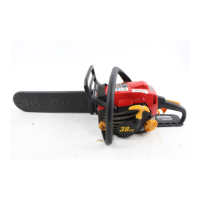REPLACING WORN CHAIN
AND SPROCKET
As the chain and sprocket wear together, they both will
change in pitch. Therefore, it is a good idea to always
change the sprocket and drum assembly whenever you
are installing a new chain. Otherwise the old sprocket will
wear down the new chain and you will have lost some of
the life of your new chain. You can tell by the wear pat-
tern whether the sprocket needs replacement. Always
change the sprocket when the wear approaches 1/32"
(0.8mm) deepness, or if you see deep wear marks on
both sides of the sprocket teeth. The clutch drum,
sprocket and clutch should be removed only by an
authorized Homelite serviceman or dealer, as servicing
must be done properly with great care. When a sprocket
and drum are replaced, all clutch parts should be
checked by your dealer. The replacement sprocket and
drum assembly includes a new grease-packed needle
bearing and inner race, and a new retaining ring.
GUIDE BAR
After each day of use, reverse the guide bar on the saw so
that the rails which were on the bottom will be on the top.
This distributes the wear for
miximum bar life. The bar
should also be cleaned everyday of use and checked for
wear and damage.
Feathering or burring of the bar rails is a normal process
of bar wear. But these burrs should be smoothed with a file
or stone as soon as they occur, because they slow down
your cutting. Also check that the bar rails are parallel (of
equal height). If not, file or grind them parallel. Pinched
rails can be opened by carefully prying them apart with a
screwdriver.
The following faults are either uneconomical or impossible
to repair (on any XL size and type bar) and will require bar
replacement:
a) Wear inside the bar rails, called "hourglass" because
of its cross section shape. It comes from too little chain
tension and permits the chain to flop over sideways.
b) Bent guide bar
-
if only slightly bowed, the bar might
be
rebent straight. But compound twistsorsharp bends
call for replacement.
c) Cracked or broken rails.
d) Spread rails-peening will not satisfactorily close the
rails of the laminated bar such as any XL bar.
Sprocket nose
PowerTipm Guide Barsareoptional equip-
ment available as XL guide bar replacements. The lub-
ricant in the sprocket nose of a Power Tip bar (in the XL
length class) is expected to last for the life of the nose
sprocket under normal conditions of use. However, the
grease can be changed by pumping through the small
lube hole in the bar nose with a needle nose grease gun.
But as long as the nose sprocket turns smoothly, we ad-
vise retaining the original lubricant. Because, once you
change thegrease you must re-lube on a daily basis there-
after.
BAR NOSE SHOULD STILL BE WARM
WHEN NOSE IS LUBRICATED
NEEDLE NOSE GREASE GUN
LUBE HOLE
We sell a grease-packed needle nose lube gun (as part
#D92680) for sprocket nose bars. You can also use needle
nose lube gun
(#24258-1) with Homelit8All-Temp Multi-
Purpose Grease (W7193) or a good quality lithium base
grease. The replacement sprocket (#A-70239-8) for
Power Tip bars comes assembled and lubricated on a
shaped mount which you can use to slide the assembly
into the bar nose. When the sprocket is positioned in the
bar nose, use the rivets in the kit to peen the sprocket
assembly into place.
SLIDE REPLACEMENT SPROCKET INTO PLACE
RIGHT OUT OF KIT PACKAGE
SPROCKET NOSE BAR
RIVETS AND OLD
NOSE REMOVED
TANKS, CAPS
and
PICK-UP FILTERS
ORIFICE OF PRESSURE-
FEED SYSTEM IS NOT
USED
IN
POSITIVE
DISPLACEMENT PUMP
$6
TYPE SYSTEM.
1.
Regular maintenance should be performed every 50
operating hours or once a year. It consistsof changing
the fuel pick-up filter in the fuel tank, and cleaning the
orifice and the screen type
pick-up filter
in thechain oil
tank.
2. These instructions include troubleshooting because
the pick-ups can become clogged any time sawdust
enters the tank.
a) When asked to cut wood, the saw will falter if the
fuel filter is clogged or the line is kinked. Flush out
the tank with clean fuel. Install a new felt filter if
the old one feels "crusty" or hard when rolled in
the fingers.
b) The saw chain must always be moist with oil in the
area of the connecting links and rivets. The flow of
oil may be blocked either at the pick-up or at the
discharge. Flush out the oil tank. Clean the oil dis-
charge hole in the guide bar mounting pad. Pick or
blow clean the screen of the pick-up filter. And if
the saw has an orifice in the pick-up line, be sure
this is open, but do not put anything through the
orifice that would enlarge its metering capacity.
c) If the above maintenance is of no avail, have the saw
checked by your Homelite Dealer or Factory
Service Center.

